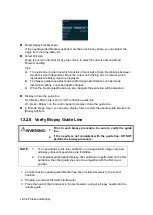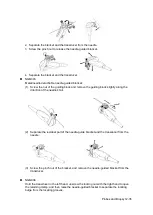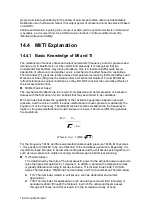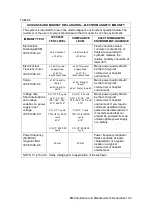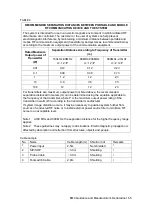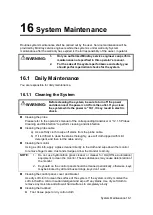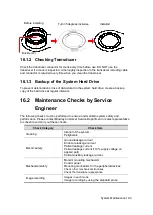
14-2 Acoustic Output
Users must take responsibility for the safety of animals and utilize ultrasound deliberately.
Deliberate use of ultrasound means that output power of ultrasound must be selected based
on ALARA.
Additional information regarding the concept of ALARA and the possible bioeffects of Ultrasound
is available in a document from the AIUM (American Institute of Ultrasound Medicine) title
“
Medical Ultrasound Safety”
.
14.4 MI/TI Explanation
14.4.1 Basic Knowledge of MI and TI
The relationship of various ultrasound output parameters (frequency, acoustic pressure and
intensity, etc) to bioeffects is not fully understood presently. It is recognized that two
fundamental mechanisms may induce bioeffects. One is a thermal bioeffect with tissue
absorption of ultrasound, and another one is a mechanical bioeffect based on cavitations.
Thermal Index (TI) gives the relative index of temperature increase by thermal bioeffect, and
Mechanical Index (MI) gives the relative index of mechanical bioeffect. TI and MI indices
reflect instantaneous output conditions, so they DO NOT consider the cumulative effects of
the total examination time.
MI (Mechanical Index):
The mechanical bioeffects are the result of compression and decompression of insonated
tissues with the formation of micro bubbles that may be referred to as cavitations.
MI is an index that shows the possibility of the cavitations generation based on acoustic
pressure, and the value in which the peak-rarefactional acoustic pressure is divided by the
square root of the frequency. Therefore MI value becomes smaller when the frequency is
higher or the peak-rarefactional acoustic pressure is lower, it becomes difficult to generate
the cavitations.
MI
=
P
r,
awf
f
C
MI
Wherein,
C
MI
= 1 (MPa /
MHz
)
For the frequency 1 MHz and the peak-rarefactional acoustic pressure 1 MPa, MI becomes
1. It is possible to think MI to be one threshold of the cavitations generation. Especially, it is
important to keep MI value to be low when both gases and the soft tissues exist together, for
such as lung exposure in cardiac scanning and bowel gas in abdominal scanning.
TI (Thermal Index):
TI is determined by the ratio of the total acoustic power to the acoustic power required to
raise the tissue temperature by 1 degree C. In addition, because the temperature rises
is greatly different according to tissue structures, TI is divided three kinds: TIS (Soft-
tissue Thermal Index), TIB (Bone Thermal Index) and TIC (Cranial-bone Thermal Index).
TIS: Thermal index related to soft tissues, such as abdominal and cardiac
applications.
TIB: Thermal index for applications, such as fetal (second and third trimester) or
neonatal cephalic (through the fontanel), in which the ultrasound beam passes
through soft tissue and a focal region is in the immediate vicinity of bone.
Содержание DP-50 Exp Vet
Страница 2: ......
Страница 34: ...2 6 System Overview 2 6 Introduction of Each Unit Right View Left View...
Страница 42: ......
Страница 68: ......
Страница 128: ......
Страница 148: ......
Страница 166: ...10 18 DICOM For details on tast manager see 9 6 Animal Task Manager...
Страница 180: ......
Страница 220: ......
Страница 224: ......
Страница 236: ......
Страница 242: ......
Страница 248: ......
Страница 249: ...Acoustic Output Reporting Table 60601 2 37 C 1 Appendix C Acoustic Output Reporting Table 60601 2 37...
Страница 342: ...D 2 Printer Adapter Type Model SONY X898MD...
Страница 343: ...P N 046 017713 02 1 0...

